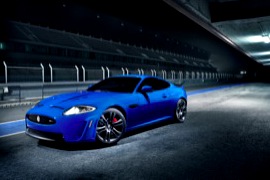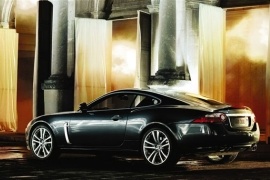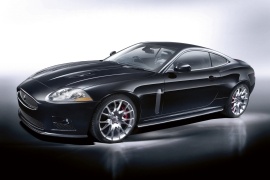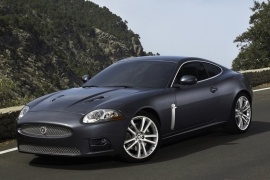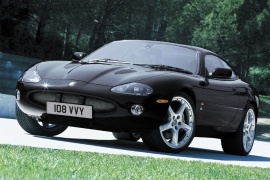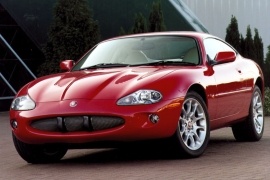JAGUAR XKR Models/Series Timeline, Specifications & Photos
First production year: 1998
Engines: Gasoline
Body style: Coupé (two-door)
Based on the experience with the previous 2008 XKR-S, Jaguar considered introducing an S version for the facelifted version of this car’s second generation, and the result was impressive.
The XKR-S came in the grueling times of the world financial crisis when economies around the world slowly moved up a bit. But there was still room to grow in the luxury-performance car market, so the British automaker took advantage of that. It took the regular XKR and enhanced its performance without sacrificing the luxurious interior, transforming the majestic go-fast GT into a vehicle that could feel at home both on a race track and in front of the Opera House.
Outside, the car impressed with its meaner look. At the front, it featured a piano-black mesh grille where the Jaguar’s silver badge took center stage. Above it, the automaker placed a pair of air intakes that helped cool the engine, while below it, under the apron, it installed a carbon-fiber splitter that enhanced the car’s look. The headlights featured arrow-style LED daytime running lights on their outer sides.
From its profile, the XKR-S showed customers that this was no regular XKR since it featured black trims around the windows line instead of the chromed ones installed on the non-S version. The large 20-inch alloy wheels with a six double-spoke design were wrapped in high-performance tiers and let bystanders see the red brake calipers. Like the previous XKR-S from 2008, the new version came with a lowered ground clearance and new side sills made from carbon fiber. Out back, instead of the ducktail installed on the regular XKR, the high-performance version came with a wing that increased downforce on the rear axle. On the lower side of the bumper, Jaguar installed a carbon-fiber diffuser that integrated the quad-exhaust system with a growling sound.
Inside, the automaker installed sports seats with integrated headrests with a race-inspired design. The leather-wrapped interior was luxurious, and the automaker installed dark aluminum trims on the dashboard, with an R-S badging in front of the passenger. Still, the center console housed the same rotary dial for the automatic transmission that automatically raised when the driver started the engine.
Under the hood, Jaguar’s engineers worked on the five-liter engine to produce more power than before. They installed a Roots-type supercharger and re-mapped the injection. As a result, the mighty V8 powerplant produced 550 PS (543 hp). The six-speed automatic gearbox provided by ZF was still strong and quick for those times standards, but it wasn’t a dual-clutch system. To help the car corner faster, Jaguar also installed new dampers with stiffer settings. In the back, the axle was fitted as standard with an adaptive differential to send the maximum power to the wheel with the highest grip. Last but not least, the automaker removed the speed limiter, so the 2011 XKR-S entered into the 300 kph (186 mph) club.
It was time for a refresh for the XKR’s second generation, and Jaguar put some effort into developing it, especially to introduce a brand new five-liter supercharged engine under the hood.
After Tata Motors bought Jaguar-Land Rover, the British automaker started to scrap all the dead weight that Ford forced the automakers to produce. That’s how the X-Type got the axe, and as a result, Jaguar’s factory running costs lowered. Then, the new engine was far more technologically advanced than the previous 4.2-liter unit. But the new owner knew that besides the engineering updates, the car needed some fresh ideas for the styling department, even though making the car look better was challenging. But somehow, it managed, and furthermore, it upgraded the interior.
Usually, when an automaker introduced a facelift for their car, they started to work on the front fascia to make it look more distinguishable from its predecessor. Jaguar took that into account, but it didn’t look like its design department clocked overtime hours for that side of the XKR. Still, the 2009 model year came with a new bumper that featured side vertical scoops that vented the front rotors. In addition, the automaker installed a lip spoiler under the apron to lower the ground effect.
From its profile, the chromed trims around the windows created a more luxurious look for Jaguar’s GT. These details emphasized the low-slung look of the greenhouse. In addition, the British car maker continued the idea introduced by Prodrive on the 2008 XKR-S model and installed deeper side sills. However, the most significant upgrades of the vehicle were made to the rear side. There, the automaker installed a duck-tail-style spoiler on the tailgate. Furthermore, the taillights featured LED technology, offering the car a cleaner, more modern look. Last but not least, the XKR featured a quad exhaust system neatly integrated under the rear bumper.
Inside, customers could choose between Rich Oak veneer, Burr Walnut, or Dark Mesh Aluminum trims to match the leather upholstery. Even though the car still used parts carried over from Ford, it had a different feel. Its instrument cluster looked cleaner. But the most significant difference from its predecessor was the newly introduced gear selector for the automatic transmission. Instead of a lever, there was a rotary dial on the center stack. It raised when the engine was started, and customers could select the driving program by rotating it left or right. In front of it was the push-button start, while behind it was the electronic parking brake.
But the most significant upgrade was under the car’s skin. The new 5.0-liter aluminum engine featured direct fuel injection and a new twin-vortex supercharger. Furthermore, the variable camshaft timing and the large intercooler helped the V8 powerplant provide 510 PS (517 hp) to the new six-speed automatic transmission. But that wasn’t all. The XKR came fitted with an active differential with a multi-clutch system controlled by a computer that helped the car send the most power to the wheel with the highest grip.
Jaguar was ready to release the facelift for the XKR’s second generation, but it couldn’t leave it to go without a final edition that was developed together with the famous Prodrive race-engineering company, and the result was this: the 2008 Jaguar XKR-S.
When Jaguar introduced the second generation of the XK-series (the XK8 and the XKR), it used the same aluminum platform used for the XJ four-door sedan. It was a masterpiece, and people understood that it had great potential. But not even the stiffer XKR couldn’t hide the fact that it was, after all, a grand tourer with a more potent engine, not a vehicle that could be thrashed around a racetrack with a grim smile on the driver’s face. On the other hand, Jaguar was known for its racing pedigree, so it had to do something to satisfy its customers, who asked if they could do better. The British automaker hired Prodrive, an engineering company specialized in race cars, to tweak the XKR, and the result was the 2008 XKR-S. It was produced in just 200 units, and it was available in just one color: black. It was the first car Jaguar launched after Ford sold it to Tata Motors.
At the front, the car looked more aggressive than the regular XKR. While it still kept the same headlights, it had a mean appearance. Unlike the regular supercharged version, the S one came with a black mesh that covered the upper grille and the air intake from the lower bumper. On the non-S version, that mesh was silver. Furthermore, underneath the apron, Prodrive installed a carbon fiber lip spoiler that reduced the ground effect. It wasn’t an aerodynamic element just for the looks.
The car’s profile revealed a lower ground clearance by 10 millimeters compared with the regular XKR. Furthermore, the car manufacturer added carbon fiber side sills. Prodrive also insisted on decreasing the unsprung masses, so it installed new alloy wheels with a fresh design. Finally, at the back, the automaker added a larger spoiler on the tailgate than on the rest of the range. Finally, the double twin exhausts that peaked from under the rear bumper flanked a newly introduced carbon fiber diffuser.
Inside, the automaker extensively used black trims. The high-bolstered front seats and the rear bench seat were covered in leather. On the dashboard, Jaguar installed a black panel in front of the passenger and on the center console that housed the infotainment system. Furthermore, the redesigned steering wheel featured buttons on it, a pair of paddle shifters behind, and a red and green R badge on the lower spoke. The infotainment system that featured navigation and Bluetooth connectivity with mobile phones was standard.
Under the hood, the automaker installed the same 420 PS engine as in the regular XKR. But thanks to the fact that the car featured a stiffer, reworked suspension, it was quicker around bends.
The first generation of the XKR coupe ended its journey in late 2005 when, at the Frankfurt Motor Show, the British automaker introduced the all-new 2006 XKR.
Ford was happy with the results provided by the XK8-XKR lineup and pushed Jaguar to launch a new generation. As a result, in early 2000, Ian Callum, who led Jaguar’s styling department, started to work on the X150 project. This time, he didn’t have to rely on the old XJS platform but on the new one shared with the XJ, which Jaguar launched in 2002. From the technical perspective, some parts were carried over from the previous generation of the XKR, but they were upgraded to comply with the new Euro 4 emission standards that were mandatory in the EU. Therefore, in late 2005, the British automaker launched the second generation of this nameplate for the 2006 model year and made its customers happy again.
The car’s look was sharper thanks to its new headlights, rounded on the inner side and with angular styling on the outer sides. Ian Callum kept the oval-shaped air intake adorned by a metallic mesh grille where the brand’s badge took center stage. The same chicken-wire style mesh covered the lower side of the bumper on the apron and was flanked by a pair of small fog lamps in individual clusters. Like the original 1998 XKR, the 2006 model year featured a pair of vents on the hood but with a much more modern styling.
From its profile, the 2006 XKR had the same GT-looking look, with its long hood and low-slung greenhouse. Behind the front wheel arches, the automaker installed vertical chromed trims. Ian Callum kept the idea of five double-spoke designs for the wheels, but in this car’s generation, it was more obvious. To emphasize the window area, the automaker installed a chromed trim that surrounded it, making it look more elegant. But the most significant difference compared to the previous XKR was at the rear, where Jaguar installed a tailgate instead of a sloped window with a separate trunk opening. Thus, access to the storage area was easier. In addition, the rear fascia featured new taillights extended from the quarter panels onto the tailgate. Last but not least, under the bumper, the XKR featured two twin exhausts on the sides instead of the single ones used on the previous XKR, the X100 version.
Inside, the automaker installed a leather-wrapped interior adorned with aluminum and light-gray trims. The driver fronted a new, three-spoke steering wheel with several buttons controlling the infotainment unit. There was also a new instrument cluster filled with two large dials for the speedometer and tachometer and a TFT display between them. The center stack housed a new touchscreen color display for the infotainment system. Jaguar had entered into a new, more digitalized era. Customers were greeted by high-bolstered bucket seats that provided adequate side support for such a fast-looking and fast-moving GT.
Under the hood, the biggest surprise was the car’ snot big surprise. Jaguar inherited the 4.2-liter supercharged V8 from its predecessor and also the six-speed automatic transmission. But still, the suspension and the brakes were different.
Jaguar refreshed the entire XK lineup in 2002, and along with the XK8, it also improved the XKR coupe and convertible, upgrading their performance and features.
While the styling imagined by Sir Ian Callum was difficult to improve without spoiling it, the interior and the drivetrain could. Thanks to financial support from Ford, Jaguar worked on the six-year-old XKR and introduced some upgrades to it. In 2002, it launched the facelifted version of this British grand tourer vehicle. It took a keen eye for detail to distinguish the 1998 and the 2002 model years of the XKR. Still, nevertheless, those were present in several key areas, and customers appreciated them.
At the front, the automaker continued installing the metallic mesh grille on the oval gap in the bumper that allowed the air to cool and feed the air to the engine. But unlike its predecessor, the new version came with a slightly different lower side of the bumper, featuring larger fog lamps. It also got a new apron that had a three-slat air intake. The hood looked similar, with the same wide crease and the two louvers that helped hot air escape from the engine bay.
From its profile, there were more changes, including the new five-spoke alloy wheels. Moreover, the rear tires were wider for a better stance and faster cornering speeds. These new sets of wheels allowed customers to see the larger, cross-drilled front and rear rotors. Previously, the XKR was fitted with vented discs up front and solid in the back. The long and low-slung greenhouse was still elegant. Jaguar's aerodynamics engineers decided that the car needed new side sills with a more vertical design to lower the ground effect. They also found out that the XKR needed a beefier spoiler on the trunk, so they added it. Finally, as a distinctive element exclusively offered on the supercharged version of the XK8, the taillights were surrounded by a slim chromed trim.
Inside, the automaker installed the same leather-wrapped interior and the wood grains on the dash with recessed dials fronting the driver. But the center stack was now available with a color display for the infotainment system. If the customers didn't choose that, they got a pair of gauges that flanked an analog clock. Between the front seats with integrated headrests, Jaguar installed a wide center console that housed the gear lever for the automatic transmission, a few buttons, and an armrest. In the back, there was still not enough room for adults.
Under its skin, the 2002 XKR could hardly hide that it relied on an almost three-decade-old platform carried over from the XJS. And yet, its improved springs and dampers made customers forget about that. But the most significant upgrade was under the hood. There, Jaguar installed a supercharged 4.2-liter V8 that produced 400 hp (405 PS) and paired it with a new six-speed automatic gearbox.
After successfully introducing the XK8 lineup in 1996, Jaguar decided to throw in a more powerful version of it, and so the XKR was born and was ready to tear up the streets.
When Ian Callum designed the XK body in the mid-80s, Ford wasn’t ruling the British automaker Jaguar yet. After it took over the helm of the car manufacturer, it postponed the launch of the grand touring car until 1996. But then, even though the customers were pleased by the two-door cat, they wanted some more oomph from the vehicle. The fastest way to do that was to add a supercharger to the 4.0-liter V8 under the hood and then come with some additional upgrades to make the car not just accelerate faster but also handle better. After all the upgrading program was finished, the XKR came alive, and Jaguar unveiled it at the 1998 Geneva Motor Show.
But Ian Callum wanted the go-fast version of the XK8 to look slightly different than its lesser-powered brother. As a result, he modified the car’s front fascia. He installed a metallic mesh on the oval-shaped grille that resembled the legendary E-Type. Furthermore, he removed the chromed horizontal slat from there. In addition, he added a pair of vents on the hood to release the hot air from the engine bay. As a final detail, the car manufacturer installed a specific badge on the car, with a red background and the “Jaguar Supercharged” lettering on the outer circle instead of the “Jaguar 4 Litre” seen on the regular XK8.
From its profile, the XKR boasted a set of 17” light-alloy wheels with a unique, five double-spoke design, with an option for an 18-inch set with a similar design and red Jaguar badges on their center caps. These were some of the distinctive details that differentiated the supercharged version from the naturally aspirated one. The low-slung greenhouse with its sloped down rear window and the rounded lines of the bodywork were the same. But still, customers who bought the R-version could also notice the tiny lip spoiler applied on the trunk’s lid.
Inside, there were no differences between the XK8 and the XKR besides the level of standard features. Customers could get the supercharged version with bucket seats at the front with tall seatbacks and integrated headrests. In front of the driver, Jaguar installed a wooden-finished dashboard with recessed dials fronting the driver for the instrument cluster. In addition, a pair of gauges and an analog clock adorned the center stack. The center console between the front occupants housed an armrest with a storage area underneath it and the J-pattern gear selector of the automatic transmission.
Under the hood, Jaguar installed the same 4.0-liter all-aluminum V8 powerplant as in the rest of the range. But unlike those, the XKR got upgraded with the help of a supercharger, which boosted the power figure by almost 80 hp. The new engine was paired with a five-speed automatic gearbox, which was the only option.
